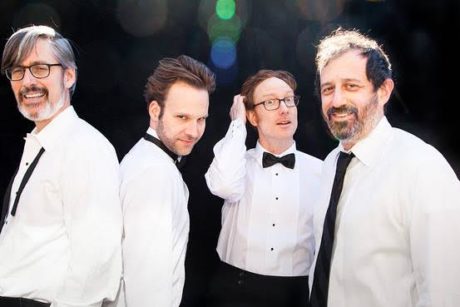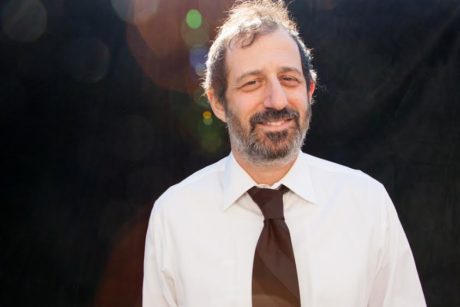The Outer Space, is a new musical by Ethan Lipton. This production, at SEI Innovation Studio at the Kimmel Center, is like a cabaret with a narrative, weaving humor, storytelling and music together. There are no actors playing characters as in a traditional musical. Instead Lipton narrates the story of a couple that decides to move to an outer space colony near Mercury, after purchasing a space ship. He sings and speaks as the instrumentalists support and ornament the tale with accompaniment. The music was composed and performed by Ethan Lipton, Vito Dieterle, Eben Levy & Ian Riggs. They sing and play sax, bass and guitars.

Director Leigh Silverman, was essential in the development of this show, even though the four men have performed together for the last 12 years. In the talk back after the opening night (December 1, 2016), they explained how the project began and was developed in the SEI Innovation Studio. Subsequently they discussed their process and how Silverman helped shape the production They are accustomed to playing music together in concert form, but not doing a “musical.” Silverman worked with them in their process to create an accessible and engaging performance from Lipton’s lyrics and the group’s musical ideas.
The show parodies current difficulties that many people face. Placing it in an undefined future near Mercury softens and distances the problems, making it a perfect context to poke fun at some of our eccentricities. Ultimately, though, the message may be that one cannot escape them, even out in space. I found The Outer Space intriguing and humorous, but at times, depressing. The husband in the couple had a view that was often pessimistic and cynical. This science-fiction voyage was absolutely absurd, so everything was tongue-in-cheek.
There are so many jokes and allusions in the play, that I may not have gotten all the meaning in one sitting. The lyrics are rich in everyday and pseudo-scientific vocabulary and they mostly rhyme. The music is live and amplified, with some recorded tracks, contributing otherworldly tones, counterpoint and harmony to the outlandish story.

While watching Lipton’s antics and listening to the music and the story, I was imagining this world that they have conjured. It is not depicted onstage, as in a traditional musical, but the use of certain sounds and the storytelling are enough that I saw the space ship, the colony, the “cat guest room” and other peculiarities in my mind.
Most entertaining, for me, was the music. The narrative is crazy and inventive, and we could follow it and relate to our own lives. What makes the production so unique and captivating is the use of music in telling this tall tale. During the talkback, the question was asked: “What style of music is this?”One of the cast members responded “A grab bag of American styles.” I enjoyed the music immensely, and I heard strains of country music, bluegrass, jazz, funk, and 1960s pop/soft rock.
In The Outer Space, the upright bass is mostly played by plucking (pizzicato), which is characteristic of the popular and folk musical styles (as opposed to classical/symphonic use of the bow). The alto and soprano saxophones definitely infused a cool jazz sound into the piece, with their smooth sustained and connected notes, and clear melodies. The guitars, acoustic and electric, were versatile, and were able to emote diverse sounds including cat meows, as in the “CAT’s theme.”
Lipton does all the talking and most of the singing, although the other musicians do sing harmonies. He has a folksy/pop voice that is always in tune, and that easily passes through speaking, Sprechstimme, (a technique between speech and singing) and singing. He enunciates clearly no matter singing or speaking, and every word is understood. Lipton has prepared well to communicate the emotion that each song demands. His delivery is always expressive, whether sad, humorous or petulant. In some of the songs he even dances! He also relates to the other musicians. They are in sync. There is no conductor, as is the case in non-classical ensembles, so the musicians must be very sensitive to each other.
There were at least fourteen distinct musical numbers, although the transitions between speaking to music were natural and organic. Since this was the opening of a new production, the songs are new, some may not even have names, and perhaps changes will be made along the way during their five week run at Joe’s Pub at the Public (Public Theater) in New York City in February 2017. At the talk back I learned that the musical themes for the animals: the two dogs, cat, and space beavers, were created by the instrumentalists and incorporated into the musical. None of these interludes had lyrics, which is understandable since animals do not use language to communicate. Each one specifically represented the animal. Sometimes animals have roles or themes in other plays, but I thought this was not standard fare and that it was off-beat and innovative in a musical about people and their issues.
My favorite songs included “Like the Apples and Aardvarks, We’re Nothing Alike A-Z,” “Yoga” and “Have You Ever Had the Dream of Going Somewhere Beautiful?” (These are the first lines of each song).
In “Apples and Aardvarks” Lipton starts with A, and speaks of two things that start with that letter, which have nothing to do with each other. He does this for every letter through Z.
In “Yoga” he enumerates countless activities that either are “yoga” or “not yoga.” The song is upbeat and parodies the contemporary obsession with this Indian practice and self-analysis. The saxophone (Vito Dieterle) nearly upstages the singing with its seductive melody that contrasts with the percussive lyrics.
“Have You Ever Had A Dream” is their last number and is satisfying and musically intricate. It starts with a solo guitar (Eben Levy), then adds bass, (Ian Riggs) played with bow, which creates a rich and vibrant sound. This is the first and only time the bass is played with bow and it stands out. The alto sax and bass have sustained pitches, while the guitarist is playing a lot of short notes. The bass goes back and forth between bow and pizzicato in the song, and the sax also alternates between different types of articulation. Bright lighting (designed by Thom Weaver) at the end of this piece was a fitting finale for this song and The Outer Space.
The Outer Space is a new imaginative musical journey that explores many of today’s day-to-day situations in a wisecracking science-fiction context. Board the ship at the Kimmel Center for a zany yet thought provoking evening!
Running Time: 90 minutes, with no intermission.
The Outer Space plays through December 3, 2016, at the Kimmel Center, SEI Innovation Studio —300 S. Broad Street, Philadelphia, PA. For tickets, call the box office at (215) 893-1999, or purchase them online.
LINK:
Ethan Lipton & His Orchestra’s ‘No Place To Go’ on Saturday, 12/15 at 8 PM at Artisphere by Annalisa Meyer.
A little taste of Ethan Lipton and his orchestra:






I attended The Outer Space show on Saturday night at SEI Innovation Studio at the Kimmel Center and loved it!!! It was so original, entertaining and funny. Congratulations……job well done!!!